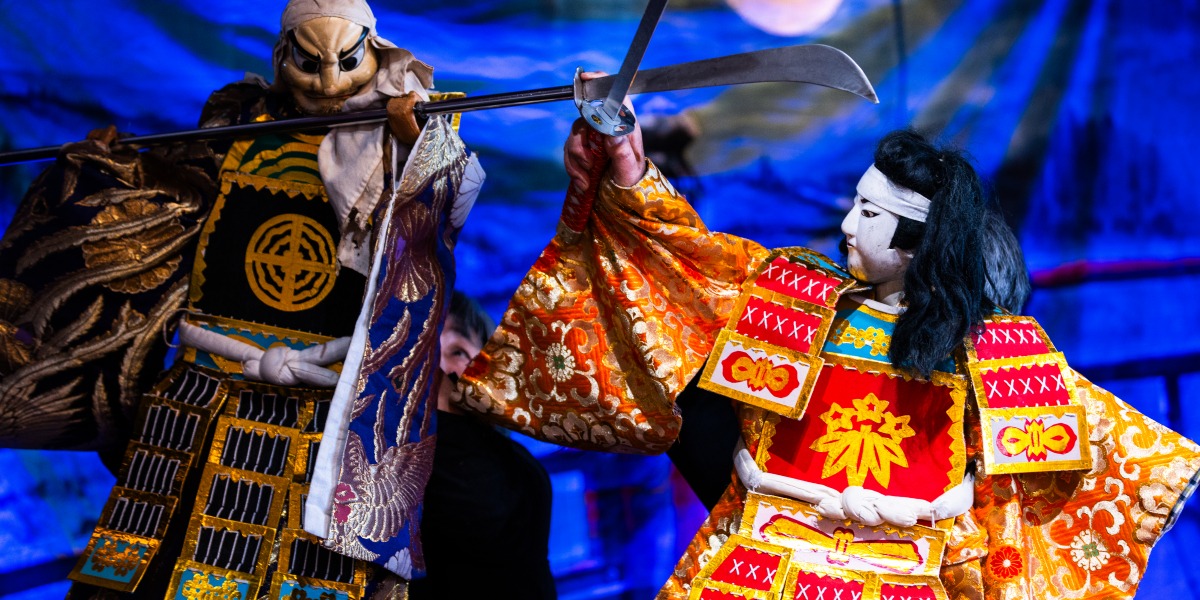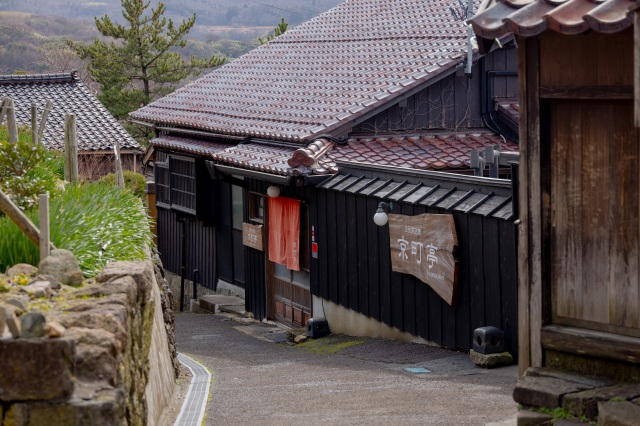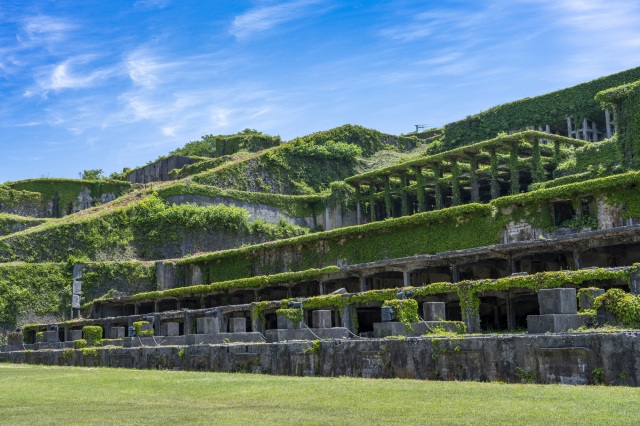Experience the traditional performing arts of Niigata and the history of Tohoku

- Suggested Time : 2 days / 1 nights
- Transport Options : Drive / Boat
Enjoy the French cuisine of Sado at a restaurant in a traditional home, accompanied by a traditional Bunya puppet performance, along Kyomachi Street, a place rich in the history of the World Heritage site Sado Kinzan (Sado Gold Mine).
START
Day1
Depart inn, Sado Aikawa district (16:50)
*Departure time may vary according to season and time of sunset.
*Departure time may vary according to season and time of sunset.
Dinner at Kyomachitei in a traditional Japanese home, including Bunya puppet performance and workshop (17:00-19:30)
In "Kyomachi street" -where the history of world cultural heritage Sado gold mine stays still-, enjoy watching traditional Bunya Nigyo-Shibai and Sado-styled french food at a Japanese folk-house restaurant

During the Edo period, Kyomachi Street flourished as a gold mining town, lined with numerous residences and shops. Now, you can enjoy a Bunraku puppet show at an old folk house restaurant perched on a hill overlooking the Sea of Japan. This traditional performance once entertained the gold miners of the area.
After the impressive puppet show, you'll be guided to a full-course French dinner prepared with local Sado ingredients. A popular highlight of the experience is the rare opportunity to learn puppet manipulation directly from the performers.
On your way back, you'll visit the Kitazawa Floatation Plant of the Sado Gold Mine. The illuminated night view of this structure creates a fantastical atmosphere, that makes you feel as if you wondered into the scenes from the movie "Laputa Castle in the Sky."
After the impressive puppet show, you'll be guided to a full-course French dinner prepared with local Sado ingredients. A popular highlight of the experience is the rare opportunity to learn puppet manipulation directly from the performers.
On your way back, you'll visit the Kitazawa Floatation Plant of the Sado Gold Mine. The illuminated night view of this structure creates a fantastical atmosphere, that makes you feel as if you wondered into the scenes from the movie "Laputa Castle in the Sky."
Kitazawa Fuyusenkoba Remains
Arrive accommodations at the Sado Aikawa district (20:10)
Stay one night at Aikawa Hot Spring
A hot spring resort on Sado Island, where you can watch the sun set and see the flames of fishing lures

A hot spring area on the west coast of Sado Island. Right before you stand Meoto-iwa (husband and wife rocks) that seem to be reaching out to embrace each other on the beautiful Nanaura Coast and are said to help to bring people together in marriage. From here you can also watch stunning sunsets, with the mighty Sea of Japan spread before you. What is more, you can also sample freshly caught seafood from the Sea of Japan, either as sashimi or grilled to your liking.In the summer you can simply walk down to the beach in your bathing costume. In the vicinity are many other tourist attractions, like the Sado Gold Mine and Sado Bugyosho (Sado Old Magistrate’s Office).
Day2
Depart inn (08:30-09:10)
Arrive Ryotsu Port (09:10) Ryotsu Port to Niigata Port via jetfoil (9:40-10:47)
*Times subject to change. Please check the latest schedule beforehand.
*Times subject to change. Please check the latest schedule beforehand.
Lunch of fresh seafood and shopping at Pier Bandai in Niigata City (11:30-12:30)
Market where you can eat till you drop, with local merry-go-round sushi and also barbecues

This market features the very best foods that Niigata has to offer, from merry-go-round sushi selling the very best fresh fish caught off the coast of Sado Island at very reasonable prices, to grilled nodoguro (rockfish) a highly sought-after fish, and the finest sake brewed from Niigata's famous rice. At the largest fresh produce market on the Sea of Japan coast there is something here to please everyone and whet every appetite, from rice to sake, from fish to meat, from vegetables to fruit, and even fresh flowers.A must-try is the grilled nodoguro rockfish only available on weekends, which is salt-grilled with head and tail still attached. The entire fish is placed on a skewer and grilled over an open charcoal flame. Sink your teeth into this delicious fish and savour the white flesh and marvellous umami-rich fat. At Pia Plaza you can also barbecue the items you have bought at the market (limited to the summer season). Barbecue sets are available to rent, including grill, charcoal and condiments, so you don't have to bring anything with you. Bandai Bridge and Toki Messe are just some of the famous sights of Niigata that are also nearby, and access is excellent. Come along if you are feeling hungry!
Sightseeing in Aizuwakamatsu City / Main tower of Tsurugajo Castle (14:30-15:30)
Japan’s only castle with elegant red tiled roofs

Tsuruga Castle, also known as Aizu Castle or Aizuwakamatsu Castle, is famed as an impregnable fortress that withstood a month-long siege by the newly formed government during the Boshin war in 1868.
The castle has undergone additional repairs since being reconstructed in 1965. Reroofing work was completed in 2011 to reproduce the look of the 17th century castle. Selected as one of Japan’s most famous 100 castles, it is the only existing castle with red tiled roofs in Japan. The stone walls of the castle tower survived the devastating 1611 earthquake and today stand in their original form.
The castle keep is now open as a museum and visitors can enjoy a panoramic view of the city of Aizuwakamatsu from the top floor. After exploring the castle, the tearoom “Rinkaku” in the Tsuruga Castle Park, built by the tea master Sen no Rikyu’s son-in-law, is the perfect place to enjoy a cup of tea in the castle’s traditional garden.
Tsuruga Castle Park is famous for its thousand cherry blossom trees illuminated at night. The surrounding trees are also illuminated in autumn to show off the vividly changing colours of their leaves. Meanwhile the castle fills with visitors during the “Aizue Candle Festival” each winter. The view of the snow-covered castle illuminated by traditional hand-decorated candles is unforgettable!
A thematic journey in the Tohoku region:Castles・Samurai
The castle has undergone additional repairs since being reconstructed in 1965. Reroofing work was completed in 2011 to reproduce the look of the 17th century castle. Selected as one of Japan’s most famous 100 castles, it is the only existing castle with red tiled roofs in Japan. The stone walls of the castle tower survived the devastating 1611 earthquake and today stand in their original form.
The castle keep is now open as a museum and visitors can enjoy a panoramic view of the city of Aizuwakamatsu from the top floor. After exploring the castle, the tearoom “Rinkaku” in the Tsuruga Castle Park, built by the tea master Sen no Rikyu’s son-in-law, is the perfect place to enjoy a cup of tea in the castle’s traditional garden.
Tsuruga Castle Park is famous for its thousand cherry blossom trees illuminated at night. The surrounding trees are also illuminated in autumn to show off the vividly changing colours of their leaves. Meanwhile the castle fills with visitors during the “Aizue Candle Festival” each winter. The view of the snow-covered castle illuminated by traditional hand-decorated candles is unforgettable!
A thematic journey in the Tohoku region:Castles・Samurai
Aizu samurai home (16:00-16:40)
Discover Aizu’s history and culture at this museum complex

Aizu Bukeyashiki is a historical site of reconstructed samurai residences of the Edo period. The preserved buildings include the residences of the former chief councillor Tanomo Saigo, a magistrate’s office and a replica of the tearoom “Rinkaku” of Tsuruga Castle.
Visitors can learn about the samurai’s lifestyle and the Boshin war at the museum on site. The residence of Tanoma Saigo is open to public from mid-December to early April.
A variety of Aizu’s traditional cultural experiences are available for visitors to enjoy including painting the local lucky charms “Akabeko” (red cattle), glass engraving, and having your picture taken dressed as a villager of the Edo period.
There is a restaurant serving regional dishes on site along with a shop offering a wide range of traditional handicrafts and local produce, a great place to find some souvenirs to take home!
Visitors can learn about the samurai’s lifestyle and the Boshin war at the museum on site. The residence of Tanoma Saigo is open to public from mid-December to early April.
A variety of Aizu’s traditional cultural experiences are available for visitors to enjoy including painting the local lucky charms “Akabeko” (red cattle), glass engraving, and having your picture taken dressed as a villager of the Edo period.
There is a restaurant serving regional dishes on site along with a shop offering a wide range of traditional handicrafts and local produce, a great place to find some souvenirs to take home!
Arrive Aizu-Wakamatsu Station (16:50)
GOAL

